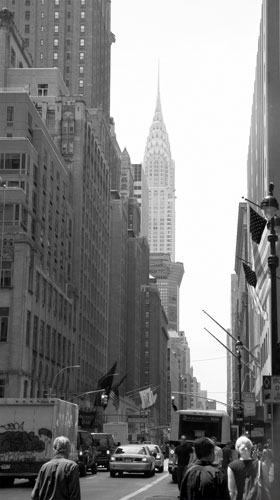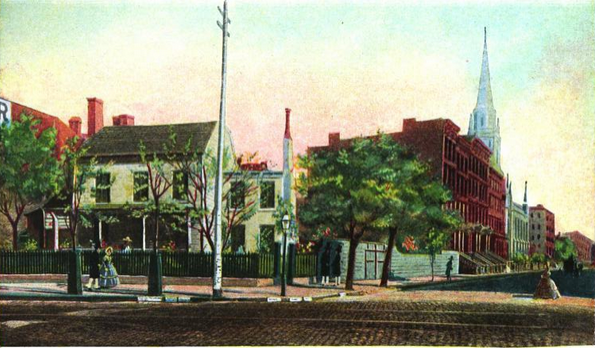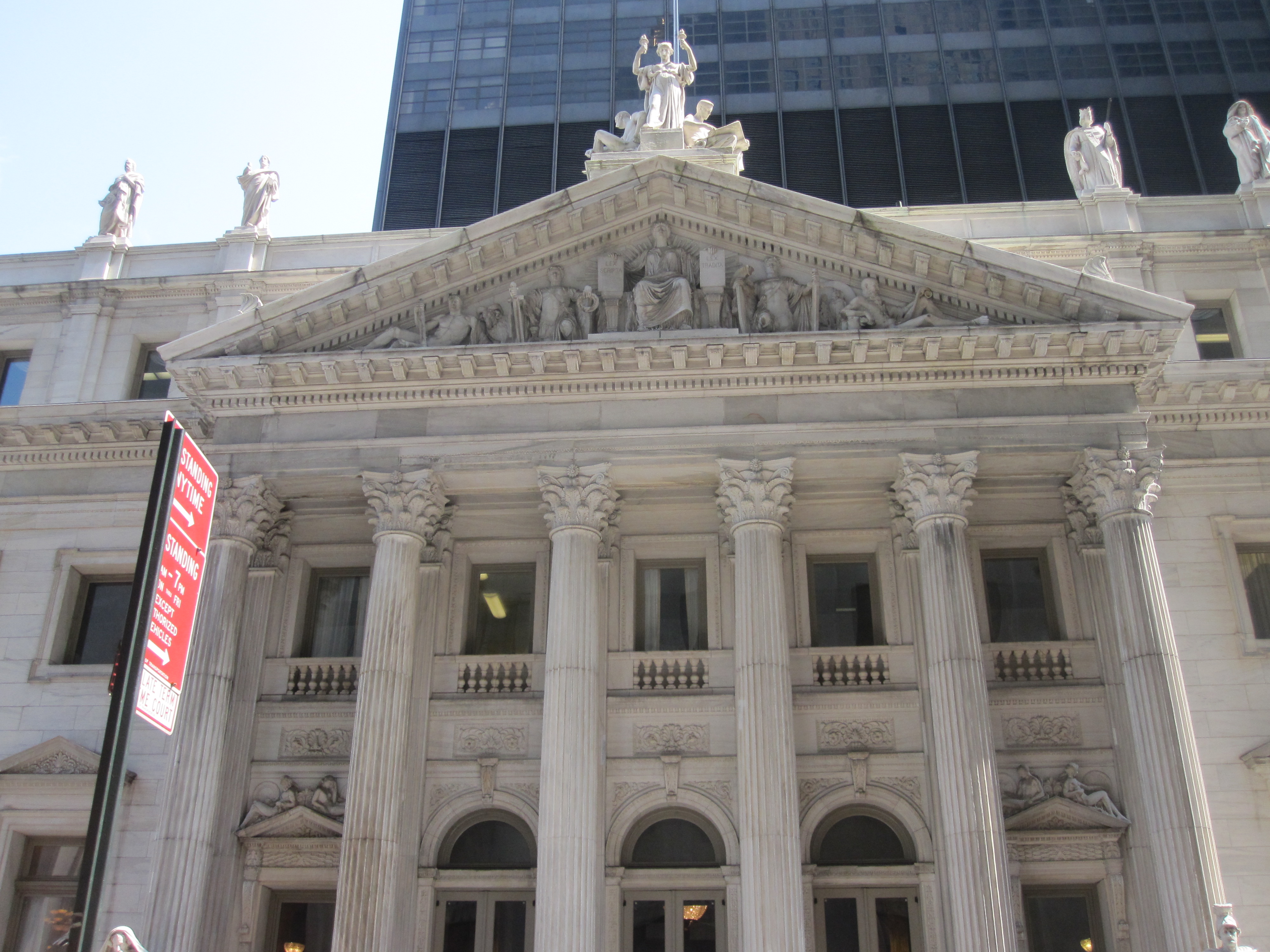|
Waldorf-Astoria (1893–1929)
The Waldorf-Astoria originated as two hotels, built side by side by feuding relatives, on Fifth Avenue in New York, New York, United States. Built in 1893 and expanded in 1897, the hotels were razed in 1929 to make way for construction of the Empire State Building. Their successor, the current Waldorf Astoria New York, was built on Park Avenue in 1931. The original Waldorf Hotel opened on March 13, 1893, at the corner of Fifth Avenue and 33rd Street, on the site where millionaire developer William Waldorf Astor had previously built his mansion. Constructed in the German Renaissance style by Henry Janeway Hardenbergh, it stood high, with fifteen public rooms and 450 guest rooms, and a further 100 rooms allocated to servants, with laundry facilities on the upper floors. It was heavily furnished with antiques purchased by founding manager and president George Boldt and his wife during an 1892 visit to Europe. The Empire Room was the largest and most lavishly adorned room in the W ... [...More Info...] [...Related Items...] OR: [Wikipedia] [Google] [Baidu] |
Renaissance Revival Architecture
Renaissance Revival architecture (sometimes referred to as "Neo-Renaissance") is a group of 19th century architectural revival styles which were neither Greek Revival nor Gothic Revival but which instead drew inspiration from a wide range of classicizing Italian modes. Under the broad designation Renaissance architecture nineteenth-century architects and critics went beyond the architectural style which began in Florence and Central Italy in the early 15th century as an expression of Renaissance humanism; they also included styles that can be identified as Mannerist or Baroque. Self-applied style designations were rife in the mid- and later nineteenth century: "Neo-Renaissance" might be applied by contemporaries to structures that others called "Italianate", or when many French Baroque features are present (Second Empire). The divergent forms of Renaissance architecture in different parts of Europe, particularly in France and Italy, has added to the difficulty of defining an ... [...More Info...] [...Related Items...] OR: [Wikipedia] [Google] [Baidu] |
Maître D'hôtel
The ''maître d'hôtel'' (; ), head waiter, host, waiter captain, or ''maître d ( , ) manages the public part, or "front of the house", of a formal restaurant. The responsibilities of a ''maître d'hôtel'' generally include supervising the waiting staff, welcoming guests and assigning tables to them, taking reservations, and ensuring that guests are satisfied. In large organizations, such as certain hotels, or cruise ships with multiple restaurants, the ''maître d'hôtel'' is often responsible for the overall dining experience, including room service and buffet services, while head waiters or supervisors are responsible for the specific restaurant or dining room they work in. Food writer Leah Zeldes writes that the role of ''maître d’hôtel'' originated as a kind of combined "host, headwaiter and dining-room manager" and, in the past, persons with this role were sometimes responsible for such operations as tableside boning of fish and mixing of salads. Traditionally, ... [...More Info...] [...Related Items...] OR: [Wikipedia] [Google] [Baidu] |
British Army
The British Army is the principal land warfare force of the United Kingdom, a part of the British Armed Forces along with the Royal Navy and the Royal Air Force. , the British Army comprises 79,380 regular full-time personnel, 4,090 Gurkhas, and 28,330 volunteer reserve personnel. The modern British Army traces back to 1707, with antecedents in the English Army and Scots Army that were created during the Restoration in 1660. The term ''British Army'' was adopted in 1707 after the Acts of Union between England and Scotland. Members of the British Army swear allegiance to the monarch as their commander-in-chief, but the Bill of Rights of 1689 and Claim of Right Act 1689 require parliamentary consent for the Crown to maintain a peacetime standing army. Therefore, Parliament approves the army by passing an Armed Forces Act at least once every five years. The army is administered by the Ministry of Defence and commanded by the Chief of the General Staff. The Brit ... [...More Info...] [...Related Items...] OR: [Wikipedia] [Google] [Baidu] |
George Washington
George Washington (February 22, 1732, 1799) was an American military officer, statesman, and Founding Father who served as the first president of the United States from 1789 to 1797. Appointed by the Continental Congress as commander of the Continental Army, Washington led the Patriot forces to victory in the American Revolutionary War and served as the president of the Constitutional Convention of 1787, which created the Constitution of the United States and the American federal government. Washington has been called the " Father of his Country" for his manifold leadership in the formative days of the country. Washington's first public office was serving as the official surveyor of Culpeper County, Virginia, from 1749 to 1750. Subsequently, he received his first military training (as well as a command with the Virginia Regiment) during the French and Indian War. He was later elected to the Virginia House of Burgesses and was named a delegate to the Continental Congress ... [...More Info...] [...Related Items...] OR: [Wikipedia] [Google] [Baidu] |
American Revolutionary War
The American Revolutionary War (April 19, 1775 – September 3, 1783), also known as the Revolutionary War or American War of Independence, was a major war of the American Revolution. Widely considered as the war that secured the independence of the United States, fighting began on April 19, 1775, followed by the Lee Resolution on July 2, 1776, and the Declaration of Independence on July 4, 1776. The American Patriots were supported by the Kingdom of France and, to a lesser extent, the Dutch Republic and the Spanish Empire, in a conflict taking place in North America, the Caribbean, and the Atlantic Ocean. Established by royal charter in the 17th and 18th centuries, the American colonies were largely autonomous in domestic affairs and commercially prosperous, trading with Britain and its Caribbean colonies, as well as other European powers via their Caribbean entrepôts. After British victory over the French in the Seven Years' War in 1763, tensions between the motherland and he ... [...More Info...] [...Related Items...] OR: [Wikipedia] [Google] [Baidu] |
Lexington Avenue
Lexington Avenue, often colloquially abbreviated as "Lex", is an avenue on the East Side of the borough of Manhattan in New York City that carries southbound one-way traffic from East 131st Street to Gramercy Park at East 21st Street. Along its , 110-block route, Lexington Avenue runs through Harlem, Carnegie Hill, the Upper East Side, Midtown, and Murray Hill to a point of origin that is centered on Gramercy Park. South of Gramercy Park, the axis continues as Irving Place from 20th Street to East 14th Street. Lexington Avenue was not one of the streets included in the Commissioners' Plan of 1811 street grid, so the addresses for cross streets do not start at an even hundred number, as they do with avenues that were originally part of the plan. History Both Lexington Avenue and Irving Place began in 1832 when Samuel Ruggles, a lawyer and real-estate developer, petitioned the New York State Legislature to approve the creation of a new north–south avenue between the exist ... [...More Info...] [...Related Items...] OR: [Wikipedia] [Google] [Baidu] |
John Jacob Astor
John Jacob Astor (born Johann Jakob Astor; July 17, 1763 – March 29, 1848) was a German-American businessman, merchant, real estate mogul, and investor who made his fortune mainly in a fur trade monopoly, by smuggling opium into China, and by investing in real estate in or around New York City. He was the first prominent member of the Astor family and the first multi-millionaire in the United States. Born in Germany, Astor emigrated to England as a teenager and worked as a musical instrument manufacturer. He moved to the United States after the American Revolutionary War. Seeing the expansion of population to the west, he entered the fur trade and built a monopoly, managing a business empire that extended to the Great Lakes region and Canada, and later expanded into the American West and Pacific coast. Seeing a decline in demand due to changing European tastes, he got out of the fur trade in 1830, diversifying by investing in New York City real estate. Astor was highly wealt ... [...More Info...] [...Related Items...] OR: [Wikipedia] [Google] [Baidu] |
Caspar Samler Farm
The Caspar Samler farm was a tract of land comprising the greater part of Fifth Avenue from Madison Square to 31st Street in what is now the Koreatown section of Manhattan, New York City, New York. History The tract of Common Lands from 28th to 32nd Streets, through which Park Avenue was later projected, was part of the farm which Caspar Samler bought in various pieces, from the City, between 1780 and 1799 for $12,100. The area now known as Madison Square Garden was owned in 1780 by Samuel, Henry, and Matthias Nicoll, and it was sold to Caspar Samler for US$2,250, becoming part of the 37 acre Caspar Samler farm. Three distinct Samler houses were located on the Commissioners' map of 1807. Samler had several children and one step daughter, Margaret Grenzeback. He died in 1810, and his daughter Barbara died in 1816 without having ever had children. The 5 acres, 3 roods, and 32 perches of land which were devised for her children, became therefore the property of the survivors of Sa ... [...More Info...] [...Related Items...] OR: [Wikipedia] [Google] [Baidu] |
Sixth Avenue
Sixth Avenue – also known as Avenue of the Americas, although this name is seldom used by New Yorkers, p.24 – is a major thoroughfare in New York City's borough of Manhattan, on which traffic runs northbound, or "uptown". It is commercial for much of its length. Sixth Avenue begins four blocks below Canal Street, at Franklin Street in TriBeCa, where the northbound Church Street divides into Sixth Avenue to the left and the local continuation of Church Street to the right, which then ends at Canal Street. From this beginning, Sixth Avenue traverses SoHo and Greenwich Village, roughly divides Chelsea from the Flatiron District and NoMad, passes through the Garment District and skirts the edge of the Theater District while passing through Midtown Manhattan. Sixth Avenue's northern end is at Central Park South, adjacent to the Artists' Gate entrance to Central Park via Center Drive. Historically, Sixth Avenue was also the name of the road that continued north of Central Pa ... [...More Info...] [...Related Items...] OR: [Wikipedia] [Google] [Baidu] |
Madison Avenue
Madison Avenue is a north-south avenue in the borough of Manhattan in New York City, United States, that carries northbound one-way traffic. It runs from Madison Square (at 23rd Street) to meet the southbound Harlem River Drive at 142nd Street. In doing so, it passes through Midtown, the Upper East Side (including Carnegie Hill), East Harlem, and Harlem. It is named after and arises from Madison Square, which is itself named after James Madison, the fourth President of the United States. Madison Avenue was not part of the original Manhattan street grid established in the Commissioners' Plan of 1811, and was carved between Park Avenue (formerly Fourth) and Fifth Avenue in 1836, due to the effort of lawyer and real estate developer Samuel B. Ruggles, who had previously purchased and developed New York's Gramercy Park in 1831, and convinced the authorities to create Lexington Avenue and Irving Place between Fourth Avenue (now Park Avenue South) and Third Avenue in order to s ... [...More Info...] [...Related Items...] OR: [Wikipedia] [Google] [Baidu] |
Ulysses S
Ulysses is one form of the Roman name for Odysseus, a hero in ancient Greek literature. Ulysses may also refer to: People * Ulysses (given name), including a list of people with this name Places in the United States * Ulysses, Kansas * Ulysses, Kentucky * Ulysses, Nebraska * Ulysses Township, Butler County, Nebraska * Ulysses, New York *Ulysses, Pennsylvania * Ulysses Township, Potter County, Pennsylvania Arts and entertainment Literature * "Ulysses" (poem), by Alfred Lord Tennyson * ''Ulysses'' (play), a 1705 play by Nicholas Rowe * ''Ulysses'', a 1902 play by Stephen Phillips * ''Ulysses'' (novel), by James Joyce * ''HMS Ulysses'' (novel), by Alistair Maclean * Ulysses (comics), two members of a fictional group in the Marvel Comics universe * Ulysses Klaue, a character in Marvel comic books * Ulysses: Jeanne d'Arc and the Alchemist Knight, a light novel Film and television * ''Ulysses'' (1954 film), starring Kirk Douglas based on the story of Homer's ''Odysse ... [...More Info...] [...Related Items...] OR: [Wikipedia] [Google] [Baidu] |
Thousand Island Dressing
Thousand Island dressing is an American salad dressing and condiment based on mayonnaise that can include olive oil, lemon juice, orange juice, paprika, Worcestershire sauce, mustard, vinegar, cream, chili sauce, tomato purée, and ketchup or Tabasco sauce. (Note: 2 different recipes are offered in this book) It also typically contains finely chopped ingredients, which can include pickles, onions, bell peppers, green olives, hard-boiled egg, parsley, pimento, chives, garlic, or chopped nuts (such as walnuts or chestnuts). (Note: 3 different recipes are offered in this book) History According to ''The Oxford Companion to American Food and Drink'', the dressing's name comes from the Thousand Islands region, located along the upper St. Lawrence River between the United States and Canada. Within that region, one common version of the dressing's origins says that a fishing guide's wife, Sophia LaLonde, made the condiment as part of her husband George's shore dinner. Often in this ... [...More Info...] [...Related Items...] OR: [Wikipedia] [Google] [Baidu] |





.jpg)



